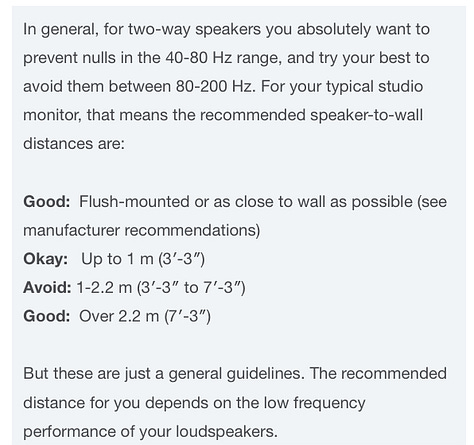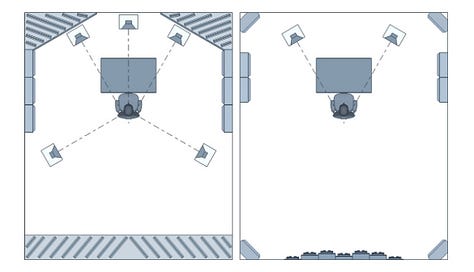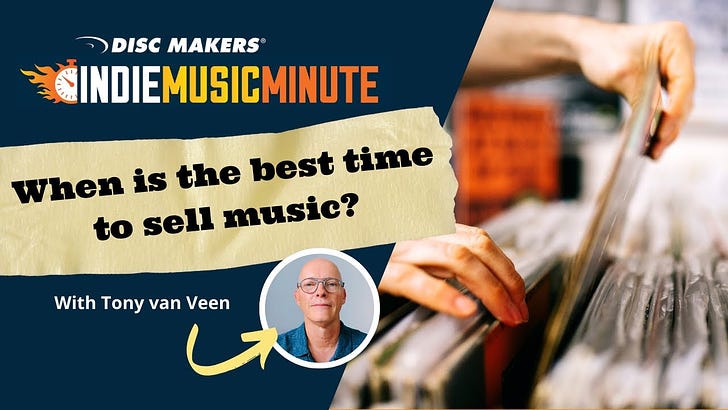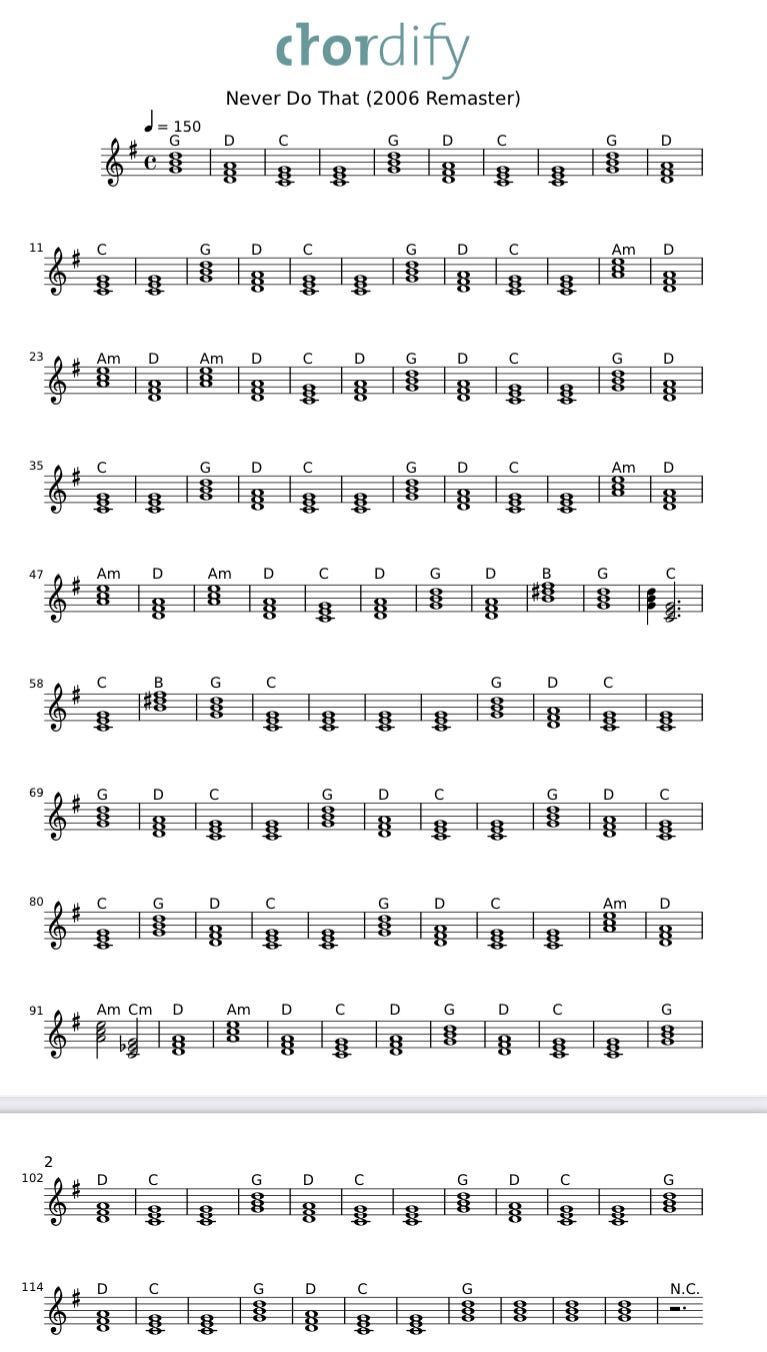Welcome to The Famous Thursday Post!
Our focus on Thursdays is on songwriting, recording, production and commercial release.
A week or so ago we talked about the effects of corners, especially the four corners of a square/rectangular room where two walls meet at the ceiling, on the signal received by microphones used during the recording process (the room isn’t going to affect a recording of your guitar direct from the pickup(s), but it will affect your vocals and mic’d instruments of any kind). The other “long corners” of concern, but somewhat less so, are the length of the walls where each meet the ceiling. Corners, especially where 2 walls meet with the ceiling, are especially troublesome for home recording. In a pro studio, high ceilings (much higher than would be found in your spare bedroom or basement, probably) can help diffuse the bass portion of the signal and lower the effects on the mid and low end of a recorded track that add to “muddiness”. But, in home recording we usually don’t have the luxury of very high ceilings and a large enough room to allow the signal to become less energetic at the “listening position”, so treating a room with some sort of acoustic dampening and reflection reduction is necessary.
We normally don’t worry as much about the corners where walls and floor meet, for a couple of reasons. First, as much as possible the floor, all the way into the corners should have rugs or at least carpeting. If the floor is already carpeted, investing in some additional, cheap rugs is a wise choice. Thick floor coverings, combined with all the “stuff” that goes in the lower portion of the studio such as recording equipment, chairs, desks, speakers, and such help diffuse the signal that is nearer to the floor, especially if there is some amount of acoustic treatment (usually panels of sound diffusing “egg crate” or other material) on blank walls. You can even make your own panels for walls:
For wall and ceiling panels that aren’t quite as labor intensive and easier to mount, I’ve used the square foam “egg crate” commercially available panels permanently glued to foam core artboard or hardboard (think in terms of what you had to use for illustrating your science fair project in junior high). The foam core boards are light enough even with foam egg crate acoustic panels attached to be stapled to walls - easy enough to paint over staple marks if you move or have to convert your studio back into a bedroom….
For the interior of the door leading into your repurposed studio, it’s possible you can use “mounting putty” for a very light acoustic panel. A couple (or more) smaller, lighter panels on the upper and lower portions of doors may work better if you’re using mounting putty to avoid damaging the door with staples or nails. Eventually the mounting putty will loosen or fail, but it’s easily replaced or reused and better than permanently damaging a wooden door, as opposed to drywall which can be patched, sanded and painted over.
Finally, acoustic “blankets” may be an option for walls or over a closet door or other surface that can’t or shouldn’t have nails or staples, like windows….. They sorta work, but I haven’t found them to be a substitute for acoustic panels. Your mileage may vary.
It’s possible to use panels on the blank portions of the ceiling as well as the walls, but make sure your fasteners holding the panel in place are secured into the ceiling joists. Just securing a panel to the drywall of the ceiling will likely not be safe, especially over time. If your room layout is pretty much set, that is, you’re happy with where your equipment is positioned and you’re not going to move your listening position, overhead panels secured through the drywall into joists can be suspended by a few inches, and with the right hardware angled a bit to reflect the signal towards the listening position (this reduces the amount of signal reflecting off of ceiling, walls and corners).
What’s a “listening position”? It’s the more or less optimal point for hearing your mix through speakers. A lot depends on the room - but it’s likely going to be more of a rectangle than a square. Either way, it’s a point a little over a third of the way along the long axis of the room, and as equidistant as possible from the right and left walls of the short axis. Windows and things like closet and entry doors will influence which direction is the best 1/3ish of the room to choose. It’s better to have those things behind you than in front of you - relative to which direction you’ll be facing when mixing - at the approximately 1/3 (okay, 38% if you’re actually measuring) point. So if you’ve found that point, that’s the place to set up your monitors and situate your interfaces and computer and speakers (monitors) and whatnot. The point you’ll actually be using for your personal “listening position” is the point of an equilateral triangle, where the base of that triangle is the formed by a line running between the centers of your monitors. They should be about 65'“ apart - a little over 5 feet. Your room dimensions will be constraints, but do the best you can. If you can measure a point from the baseline formed between the monitors that intersects with the equidistant axes of the speakers’ points on the triangle and sounds pretty good, you’re probably close enough. (Ummm, what? Just position your speakers about 5 feet apart if you can, angle them equally, but somewhat, toward each other until the sound will intersect - eyeball it - that’s probably close enough. It isn’t actually rocket surgery unless you’re getting paid, then it sorta is). One problem is that this point will quite possibly be farther than arm’s reach to your computer. If you’re using a laptop and a long enough USB cable to your interface you can overcome this, but in either event mark the point on the floor or directly above on the ceiling or if necessary on points on the walls to left and right. After awhile you’ll just sort of know where the point is, and marking is less important, but at first, it’s kind of critical.
This link may be helpful: Studio Setup - but if you REALLY want to get down in the weeds, try this - it’s a great link, with lots of technical (but reasonably well explained) stuff: Room Setup
Next week we’ll talk about using software and a specialized microphone to determine some helpful ways to “calibrate” your studio/room before and after setup.
Clean Bass Sound - this link is from an outfit called Mastering The Mix. A lot of their blog type writing is pretty good, and this one talks about a lot of the stuff we’re discussing above, but they also sell plugins for your DAW. Nothing wrong with that, but they always use what could be some informative stuff around what turns out to be a way to use, and only use, the plugin that the supposed blog is selling that day. This one sort of goes along with some of the stuff we’re talking about above, but then turns into an ad for some plugin. That’s the point where they lose me, your mileage may vary.
From The “Just Plain Odd” Files:
So, this article from Wired Magazine details how there are companies who, after buying artist’s song catalogs, and thereby are able to collect royalties from the the rights the artists have sold, are offering sales of “shares” in those royalties. So a percentage of a percentage…. Kind of like stock in a company, but not. More of a bet that some artist’s songs will continue to sell for the foreseeable future (or at least the life of the copyright - 75 years, with some caveats to that), and that those royalties will generate income for the new rightsholders/shareholders via royalties for Composer/lyrics, Publisher, and Sound Recordings copyrights. So, maybe. I’m skeptical of the viability of the concept to say the least.
But, there is a personal note for me to add to this. I’m not famous or anything. As you know, I do have a song out, and another coming soon. I have 9 songs total copyrighted with the US Copyright Office and will be copyrighting more in the future. I also have songs registered with my PRO, ASCAP. But the songs with ASCAP are just the titles, the only place my copyrighted lyrics are available are with the Copyright Office. Just after I released “Long Road Back” a few months ago, I started getting these emails from some guy, just a first name, saying he and his company (unnamed) were interested in buying my catalog of songs. No offer of price, no real information, just a “contact me if interested” type of deal. Since I wasn’t interested, and it sounded pretty scam-laden, I ignored it until the emails became more frequent (always the same name, text and email address), until I finally just blocked the sender. Again, a bet on my songs becoming famous enough to generate significant royalties would be far from prudent, but it made me wonder if there wasn’t some sort of “bundling” scam, where in return for an investment in a few “name” artist’s potential royalties (think Neil Young, Paul Simon, Bob Dylan, etc), the investor would also have to pay for some of the “nobodies” like me whose rights were picked up for next to nothing, but sold as an expensive bundle with the “names” rights. Dunno, didn’t make sense any other way to me….FWIW
The Space Saving Disclaimer!: This Substack, (not just the first one!) is free, always will be, none of the people or companies or products I link to or write about pay me a damn thing. Neither do you unless you buy my song(s) (See what I did there?). Some stuff may be copyrighted by somebody else…whatever. “Fair Use” doctrine for “educational purposes” (Link: Fair Use) applies, suckers! No stinkin’ AI here unless it’s in something I link to. So.
Michael Acoustic
Today’s musician’s quote:
“Music is a language that doesn’t speak in particular words. It speaks in emotions, and if it’s in the bones, it’s in the bones.”
Keith Richards
Lots Of Links Today:
From Carvin Audio: The Power Of Feedback - while Michael Acoustic is mostly a Substack about the acoustic guitar and related things, I’m sure many of my readers, like me, play electric guitar as well, and use various pedals with both types of guitar. I thought this article from Carvin was interesting and some of the pedal effects discussed can be recreated in your DAW even without the pedal.
From Songtown, a trio of songwriting related links:
Never Too Late - This could apply at many stages of life, there are probably 20 year olds out there thinking the opportunity passed them by, just as there are folks even older than me believing that too. But that’s incorrect at any age, and I’m living proof that it’s never too late. It’s not age, it’s how you look at life no matter your age that matters, though if you’re not a good writer, it’s also not too late to read well, take an English composition class at your local communication class, and challenge yourself to do things you thought you couldn’t. Just sayin’…
Splits - Yes, we talk about money a lot on here - who earns it, how it’s earned, and how to make sure you receive what you’re entitled to. If you’re self-published, a task which requires owning a business entity (usually an LLC - Limited Liability Company), as well as compositions with lyrics and sound recordings, you really only need to split royalties with yourself, but make sure you pay your session musicians, producer, and audio engineer well! Also, your distributor and publishing admin are going to get a cut and an upfront fee. Price of doing business, unless you have months of free time to upload, track and manage all the streaming services you’re on (trust me, you don’t as an individual…).
Frustrations - This is a link to a podcast, and I’m not a fan of podcasts - no offense, podcasters, I just find it difficult to sit still for the length of most podcasts, and let’s be honest - unless the folks on the mics are seriously sticking to the purpose, there’s a lot of screwing around, joking asides, whatever. That sort of thing tries my soul, so I avoid them. This one is by a couple of experienced songwriters and deals with the frustrations that can arise for songwriters. Since they probably know what they’re talking about I included it for you folks who like podcasts….
From Disc Makers:
Music Success and Longevity - So, this is includes video with Mr. Van Veen. I may have posted this previously, don’t remember. How is this different from a podcast? First off, it’s just him and there’s an outline with text of most of it if you want to skip ahead. So. If you’re planning more than just experimenting with the music biz, this is good.
Guide To Concert Promotion - This says “concert promotion” but it really means “live event”. That could be something much simpler than what we think of when we read “concert”. Do you have fans, friends, family, people who just know you? Are you maybe going to do a set or two at a coffeehouse, bar, street corner, charity event, county fair, local celebration, farmer’s market, whatever? Probably should let folks know….this article is a good start.
How To Make Music - Yeah, it’s not really a “how to” - if you could learn that by reading an article or two there would likely be even more competition for gigs than there already is. This is more of “here’s some steps to take along the way to learning how to make music”. Interesting though.
Shameless Self Promotion Section: I moved this back down here this week, but you know, MLC statements are coming out soon, just saying…
My song is out! Link: “Long Road Back” (click on link for streaming options)
Some memes and stuff:



Odds and Ends: A Song To Play
Not obscure at all, but this song came up in discussions this week. It immediately took me back to “those” days and it’s just so great, I couldn’t help but listen again. One of my favorite bands and featured on Michael Acoustic many times, but I had forgotten this song with it’s essential “Pretenders sound” and Ms. Hynde’s signature vocals:
4/4 Time, Key of GMaj, a very quick 150 BPM, pretty much a 4 chord, I, V, IV, with a ii- for flavor until the bridge, when the non-diatonic BMaj chord makes a cool appearance and the somewhat odd, also non-diatonic Cm pops in later (?).
Never Do That lyrics Link: Never Do That
Let me stay
One more day
It would mean so much to me
I won't make a sound
I'll just hang around
I'll sit where the last one sat
But oh no
I'd never do that
Take my mouth as far as you can see
It stretches father than I care to think
Put me out of my misery
If I could keep it shut
I wouldn't be in this rut
With less chance than a laboratory rat
Oh no
I'd never do that
You're a master of illusion
You say you do - but you don't
You think I will - I know I won't
When I see you sitting there
It sends a shock right through me
I never thought an ordinary chair
Could have such poetry
I don't deserve your time
I haven't got the tact
I live above my means in fact
Oh no
I'd never do that
I'd never do that
I'd never do that
I'd never do that
Cheers, and keep playing!
Michael Acoustic
“It’s never really final - you just run out of things you can bear to change…”






Just curious, Michael. Have you ever visited the recording studios at Muscle Shoals? Abbey Road? Sun?